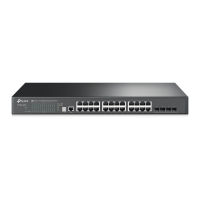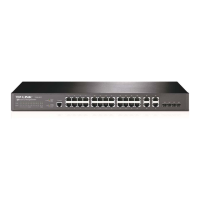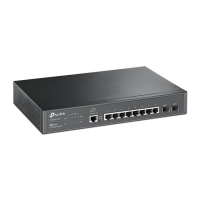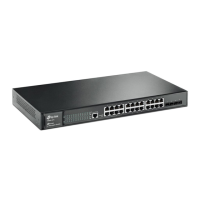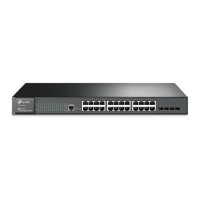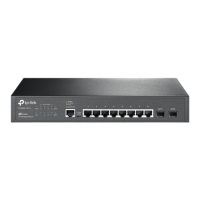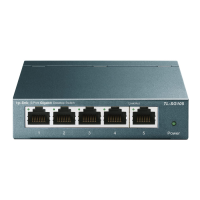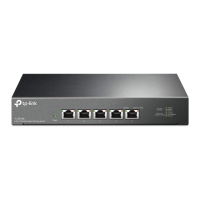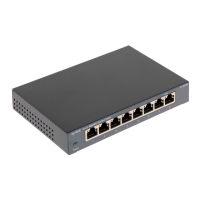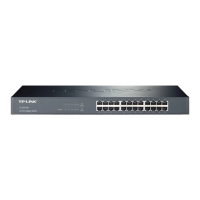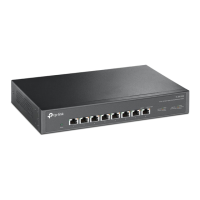Do you have a question about the TP-Link T2700G-28TQ and is the answer not in the manual?
Explains how to log on to the switch via console, Telnet, or SSH connections.
Details the different command modes (User EXEC, Privileged EXEC, Global Config) and transitions.
Describes the two security levels (User and Admin) and their access privileges.
Explains formatting conventions, special characters, and parameter formats used in the guide.
Command to access Privileged EXEC Mode from User EXEC Mode.
Command to access Global Configuration Mode from Privileged EXEC Mode.
Command to return to the previous mode or disconnect from the switch.
Displays the history of recently entered commands.
Configures the stack member number and its priority for stack management.
Configures the stack authentication mode (simple or MD5) for security.
Displays the current stack's information and status.
Creates or deletes IEEE 802.1Q VLANs and accesses VLAN Configuration Mode.
Configures the Link Type (access, trunk, general) for Ethernet ports.
Adds or removes Trunk ports from specific VLANs or all VLANs.
Creates a MAC-based VLAN entry, associating a MAC address with a VLAN ID.
Enables a port for the MAC-based VLAN feature.
Creates a Protocol-based VLAN template for classifying VLANs based on protocols.
Enables the VLAN-VPN function globally for double-tagged VLAN traffic.
Adds a VLAN Mapping entry on a specified port for VLAN-VPN.
Enables the Voice VLAN function for voice data stream traffic.
Configures the Voice VLAN mode (manual or auto) for an Ethernet port.
Configures a designated VLAN as the primary VLAN of a Private VLAN.
Configures the private VLAN mode (promiscuous or host) for a switchport.
Enables the GVRP (GARP VLAN registration protocol) function globally.
Adds a port to an EtherChannel Group and configures its mode (on, active, passive).
Configures the Aggregate Arithmetic for LAG (src-dst-mac or src-dst-ip).
Adds a new user or modifies existing users' information, setting their login password.
Limits user login to a specific IP address range.
Manually binds IP, MAC, VLAN, and Port number for security features.
Enables DHCP Snooping globally to monitor IP address assignment and record host information.
Enables the ARP Detection function globally to protect against ARP cheating and attacks.
Configures ports as Trusted Ports where ARP Detect is unnecessary.
Configures IP Verify Source mode for ports to filter IP packets based on IP-MAC binding rules.
Enables the DoS defend function globally to protect against denial-of-service attacks.
Enables the IEEE 802.1X function globally for LAN port access control via authentication.
Configures the Authentication Method (PAP or EAP-MD5) for IEEE 802.1X.
Stores system log messages to an internal buffer (RAM) for monitoring.
Stores log messages in a file on the switch's flash memory for persistent logging.
Configures syslog server hosts to receive logging messages remotely.
Enables the SSH function globally for secure remote management.
Enables specific SSH protocol versions (v1 or v2) for remote management.
Enables the SSL function globally for secure HTTPS connections.
Adds static MAC address entries to bind MAC to VLAN and port for efficient forwarding.
Configures Port Security by limiting the maximum number of MAC addresses learned on a port.
Manually configures the system date and time for accurate logging and operations.
Configures the time zone and NTP server for automatic time synchronization.
Enters interface configuration mode for Gigabit Ethernet ports.
Enters interface configuration mode for multiple Gigabit Ethernet ports simultaneously.
Disables an Ethernet port to stop traffic flow, and can be re-enabled with 'no shutdown'.
Configures CoS (Class of Service) priority for ports to optimize network performance.
Configures the Schedule Mode (SP, WRR, SP+WRR, EQU) for priority queues.
Configures the monitoring port for a port mirroring session.
Configures monitored ports for a port mirroring session, specifying traffic direction.
Configures the forward port list of a port to restrict communication between ports.
Enables the loopback detection function globally to detect network loops.
Configures process-mode and recovery-mode for loopback detection.
Creates standard-IP ACLs and extend-IP ACLs with a specified ID.
Adds a Policy to control data packets matching ACL rules.
Adds ACLs to policies and creates actions like stream mirror or redirect.
Enables the STP function globally for Spanning Tree Protocol.
Configures the STP mode of the switch (STP, RSTP, MSTP).
Accesses MST Configuration Mode to configure VLAN-Instance mapping and region name.
Configures the priority of MST instances for root bridge selection.
Enables IGMP Snooping globally to prevent multicast group broadcasting.
Configures static multicast groups on specified interface VLANs.
Enables the SNMP function globally for network management.
Manages and configures SNMP groups using VACM and USM for authentication.
Adds SNMP users, classifying them by group, security model, and access rights.
Enables SNMP standard traps (linkup, linkdown, warmstart, coldstart).
Configures history sample entries for RMON to collect network statistics periodically.
Enables the LLDP function globally for devices to advertise their information to neighbors.
Configures LLDP transmission parameters like tx-interval, tx-delay, and notify-interval.
Enables the LLDP-MED feature for a port, changing its Admin Status to Tx&Rx.
Creates a new cluster and defines its IP address pool for management.
Adds or deletes member switches to the cluster using their MAC addresses.
Configures static routes to define packet forwarding paths manually.
Enables or disables the Layer 3 routing function globally.
Enables DHCP service globally, including Server and Relay functions.
Specifies reserved IP addresses that are forbidden for allocation in the DHCP pool.
Creates an address pool for the DHCP Server and enters DHCP configuration mode.
Reserves static IP addresses bound with hardware (MAC) addresses in the DHCP pool.
Specifies the default gateway address for the DHCP address pool.
Adds DHCP Server addresses to the Layer 3 interface for DHCP Relay.
Enables Option 82 support in DHCP Relay for enhanced client information.
Enables Proxy ARP function on specified VLAN or routed interfaces to help hosts learn MAC addresses.
Enables IGMP function on the specified interface to track multicast groups.
Configures static multicast groups on specified interface VLANs.
Configures the maximum number of multicast groups a port can join.
Enables IP multicast routing function globally.
Enables PIM function on the specified interface (dense or sparse mode).
Configures the static RP address for PIM.
Adds or modifies static multicast routing entries for RPF checks.
Creates an OSPF routing process and enters router configuration mode.
Configures the network of a specified area for OSPF, assigning interfaces to the area.
Configures redistribution of external routes (static, RIP, OSPF) into the OSPF domain.
Displays the LSDB (Link State Database) of OSPF, including detailed LSA information.
Displays OSPF interface information, including summary or detailed information.
Explains how to log on to the switch via console, Telnet, or SSH connections.
Details the different command modes (User EXEC, Privileged EXEC, Global Config) and transitions.
Describes the two security levels (User and Admin) and their access privileges.
Explains formatting conventions, special characters, and parameter formats used in the guide.
Command to access Privileged EXEC Mode from User EXEC Mode.
Command to access Global Configuration Mode from Privileged EXEC Mode.
Command to return to the previous mode or disconnect from the switch.
Displays the history of recently entered commands.
Configures the stack member number and its priority for stack management.
Configures the stack authentication mode (simple or MD5) for security.
Displays the current stack's information and status.
Creates or deletes IEEE 802.1Q VLANs and accesses VLAN Configuration Mode.
Configures the Link Type (access, trunk, general) for Ethernet ports.
Adds or removes Trunk ports from specific VLANs or all VLANs.
Creates a MAC-based VLAN entry, associating a MAC address with a VLAN ID.
Enables a port for the MAC-based VLAN feature.
Creates a Protocol-based VLAN template for classifying VLANs based on protocols.
Enables the VLAN-VPN function globally for double-tagged VLAN traffic.
Adds a VLAN Mapping entry on a specified port for VLAN-VPN.
Enables the Voice VLAN function for voice data stream traffic.
Configures the Voice VLAN mode (manual or auto) for an Ethernet port.
Configures a designated VLAN as the primary VLAN of a Private VLAN.
Configures the private VLAN mode (promiscuous or host) for a switchport.
Enables the GVRP (GARP VLAN registration protocol) function globally.
Adds a port to an EtherChannel Group and configures its mode (on, active, passive).
Configures the Aggregate Arithmetic for LAG (src-dst-mac or src-dst-ip).
Adds a new user or modifies existing users' information, setting their login password.
Limits user login to a specific IP address range.
Manually binds IP, MAC, VLAN, and Port number for security features.
Enables DHCP Snooping globally to monitor IP address assignment and record host information.
Enables the ARP Detection function globally to protect against ARP cheating and attacks.
Configures ports as Trusted Ports where ARP Detect is unnecessary.
Configures IP Verify Source mode for ports to filter IP packets based on IP-MAC binding rules.
Enables the DoS defend function globally to protect against denial-of-service attacks.
Enables the IEEE 802.1X function globally for LAN port access control via authentication.
Configures the Authentication Method (PAP or EAP-MD5) for IEEE 802.1X.
Stores system log messages to an internal buffer (RAM) for monitoring.
Stores log messages in a file on the switch's flash memory for persistent logging.
Configures syslog server hosts to receive logging messages remotely.
Enables the SSH function globally for secure remote management.
Enables specific SSH protocol versions (v1 or v2) for remote management.
Enables the SSL function globally for secure HTTPS connections.
Adds static MAC address entries to bind MAC to VLAN and port for efficient forwarding.
Configures Port Security by limiting the maximum number of MAC addresses learned on a port.
Manually configures the system date and time for accurate logging and operations.
Configures the time zone and NTP server for automatic time synchronization.
Enters interface configuration mode for Gigabit Ethernet ports.
Enters interface configuration mode for multiple Gigabit Ethernet ports simultaneously.
Disables an Ethernet port to stop traffic flow, and can be re-enabled with 'no shutdown'.
Configures CoS (Class of Service) priority for ports to optimize network performance.
Configures the Schedule Mode (SP, WRR, SP+WRR, EQU) for priority queues.
Configures the monitoring port for a port mirroring session.
Configures monitored ports for a port mirroring session, specifying traffic direction.
Configures the forward port list of a port to restrict communication between ports.
Enables the loopback detection function globally to detect network loops.
Configures process-mode and recovery-mode for loopback detection.
Creates standard-IP ACLs and extend-IP ACLs with a specified ID.
Adds a Policy to control data packets matching ACL rules.
Adds ACLs to policies and creates actions like stream mirror or redirect.
Enables the STP function globally for Spanning Tree Protocol.
Configures the STP mode of the switch (STP, RSTP, MSTP).
Accesses MST Configuration Mode to configure VLAN-Instance mapping and region name.
Configures the priority of MST instances for root bridge selection.
Enables IGMP Snooping globally to prevent multicast group broadcasting.
Configures static multicast groups on specified interface VLANs.
Enables the SNMP function globally for network management.
Manages and configures SNMP groups using VACM and USM for authentication.
Adds SNMP users, classifying them by group, security model, and access rights.
Enables SNMP standard traps (linkup, linkdown, warmstart, coldstart).
Configures history sample entries for RMON to collect network statistics periodically.
Enables the LLDP function globally for devices to advertise their information to neighbors.
Configures LLDP transmission parameters like tx-interval, tx-delay, and notify-interval.
Enables the LLDP-MED feature for a port, changing its Admin Status to Tx&Rx.
Creates a new cluster and defines its IP address pool for management.
Adds or deletes member switches to the cluster using their MAC addresses.
Configures static routes to define packet forwarding paths manually.
Enables or disables the Layer 3 routing function globally.
Enables DHCP service globally, including Server and Relay functions.
Specifies reserved IP addresses that are forbidden for allocation in the DHCP pool.
Creates an address pool for the DHCP Server and enters DHCP configuration mode.
Reserves static IP addresses bound with hardware (MAC) addresses in the DHCP pool.
Specifies the default gateway address for the DHCP address pool.
Adds DHCP Server addresses to the Layer 3 interface for DHCP Relay.
Enables Option 82 support in DHCP Relay for enhanced client information.
Enables Proxy ARP function on specified VLAN or routed interfaces to help hosts learn MAC addresses.
Enables IGMP function on the specified interface to track multicast groups.
Configures static multicast groups on specified interface VLANs.
Configures the maximum number of multicast groups a port can join.
Enables IP multicast routing function globally.
Enables PIM function on the specified interface (dense or sparse mode).
Configures the static RP address for PIM.
Adds or modifies static multicast routing entries for RPF checks.
Creates an OSPF routing process and enters router configuration mode.
Configures the network of a specified area for OSPF, assigning interfaces to the area.
Configures redistribution of external routes (static, RIP, OSPF) into the OSPF domain.
Displays the LSDB (Link State Database) of OSPF, including detailed LSA information.
Displays OSPF interface information, including summary or detailed information.
